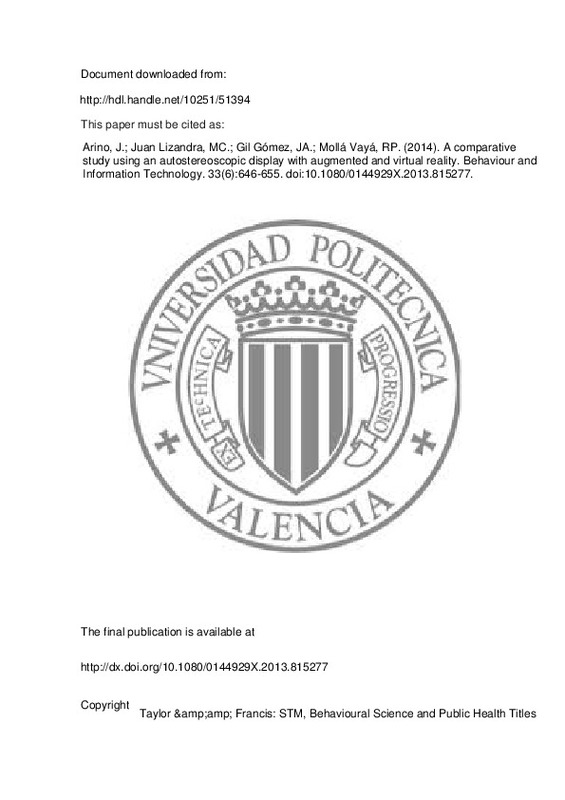Azuma, R. T. (1997). A Survey of Augmented Reality. Presence: Teleoperators and Virtual Environments, 6(4), 355-385. doi:10.1162/pres.1997.6.4.355
Blum, T.et al. 2012. Mirracle: augmented reality in-situ visualization of human anatomy using a magic mirror.In: IEEE virtual reality workshops, 4–8 March 2012, Costa Mesa, CA, USA. Washington, DC: IEEE Computer Society, 169–170.
Botden, S. M. B. I., Buzink, S. N., Schijven, M. P., & Jakimowicz, J. J. (2007). Augmented versus Virtual Reality Laparoscopic Simulation: What Is the Difference? World Journal of Surgery, 31(4), 764-772. doi:10.1007/s00268-006-0724-y
[+]
Azuma, R. T. (1997). A Survey of Augmented Reality. Presence: Teleoperators and Virtual Environments, 6(4), 355-385. doi:10.1162/pres.1997.6.4.355
Blum, T.et al. 2012. Mirracle: augmented reality in-situ visualization of human anatomy using a magic mirror.In: IEEE virtual reality workshops, 4–8 March 2012, Costa Mesa, CA, USA. Washington, DC: IEEE Computer Society, 169–170.
Botden, S. M. B. I., Buzink, S. N., Schijven, M. P., & Jakimowicz, J. J. (2007). Augmented versus Virtual Reality Laparoscopic Simulation: What Is the Difference? World Journal of Surgery, 31(4), 764-772. doi:10.1007/s00268-006-0724-y
Chittaro, L., & Ranon, R. (2007). Web3D technologies in learning, education and training: Motivations, issues, opportunities. Computers & Education, 49(1), 3-18. doi:10.1016/j.compedu.2005.06.002
Dodgson, N. A. (2005). Autostereoscopic 3D displays. Computer, 38(8), 31-36. doi:10.1109/mc.2005.252
Ehara, J., & Saito, H. (2006). Texture overlay for virtual clothing based on PCA of silhouettes. 2006 IEEE/ACM International Symposium on Mixed and Augmented Reality. doi:10.1109/ismar.2006.297805
Eisert, P., Fechteler, P., & Rurainsky, J. (2008). 3-D Tracking of shoes for Virtual Mirror applications. 2008 IEEE Conference on Computer Vision and Pattern Recognition. doi:10.1109/cvpr.2008.4587566
Fiala, M. (2007). Magic Mirror System with Hand-held and Wearable Augmentations. 2007 IEEE Virtual Reality Conference. doi:10.1109/vr.2007.352493
Froner, B., Holliman, N. S., & Liversedge, S. P. (2008). A comparative study of fine depth perception on two-view 3D displays. Displays, 29(5), 440-450. doi:10.1016/j.displa.2008.03.001
Holliman, N. S., Dodgson, N. A., Favalora, G. E., & Pockett, L. (2011). Three-Dimensional Displays: A Review and Applications Analysis. IEEE Transactions on Broadcasting, 57(2), 362-371. doi:10.1109/tbc.2011.2130930
Ilgner, J. F. R., Kawai, T., Shibata, T., Yamazoe, T., & Westhofen, M. (2006). Evaluation of stereoscopic medical video content on an autostereoscopic display for undergraduate medical education. Stereoscopic Displays and Virtual Reality Systems XIII. doi:10.1117/12.647591
Jeong, J.-S., Park, C., Kim, M., Oh, W.-K., & Yoo, K.-H. (2011). Development of a 3D Virtual Laboratory with Motion Sensor for Physics Education. Ubiquitous Computing and Multimedia Applications, 253-262. doi:10.1007/978-3-642-20975-8_28
Jones, J. A., Swan, J. E., Singh, G., Kolstad, E., & Ellis, S. R. (2008). The effects of virtual reality, augmented reality, and motion parallax on egocentric depth perception. Proceedings of the 5th symposium on Applied perception in graphics and visualization - APGV ’08. doi:10.1145/1394281.1394283
Juan, M. C., & Pérez, D. (2010). Using augmented and virtual reality for the development of acrophobic scenarios. Comparison of the levels of presence and anxiety. Computers & Graphics, 34(6), 756-766. doi:10.1016/j.cag.2010.08.001
Kaufmann, H., & Csisinko, M. (2011). Wireless Displays in Educational Augmented Reality Applications. Handbook of Augmented Reality, 157-175. doi:10.1007/978-1-4614-0064-6_6
Kaufmann, H., & Meyer, B. (2008). Simulating educational physical experiments in augmented reality. ACM SIGGRAPH ASIA 2008 educators programme on - SIGGRAPH Asia ’08. doi:10.1145/1507713.1507717
Konrad, J. (2011). 3D Displays. Optical and Digital Image Processing, 369-395. doi:10.1002/9783527635245.ch17
Konrad, J., & Halle, M. (2007). 3-D Displays and Signal Processing. IEEE Signal Processing Magazine, 24(6), 97-111. doi:10.1109/msp.2007.905706
Kwon, H., & Choi, H.-J. (2012). A time-sequential mutli-view autostereoscopic display without resolution loss using a multi-directional backlight unit and an LCD panel. Stereoscopic Displays and Applications XXIII. doi:10.1117/12.907793
Livingston, M. A., Zanbaka, C., Swan, J. E., & Smallman, H. S. (s. f.). Objective measures for the effectiveness of augmented reality. IEEE Proceedings. VR 2005. Virtual Reality, 2005. doi:10.1109/vr.2005.1492798
Monahan, T., McArdle, G., & Bertolotto, M. (2008). Virtual reality for collaborative e-learning. Computers & Education, 50(4), 1339-1353. doi:10.1016/j.compedu.2006.12.008
Montgomery, D. J., Woodgate, G. J., Jacobs, A. M. S., Harrold, J., & Ezra, D. (2001). <title>Performance of a flat-panel display system convertible between 2D and autostereoscopic 3D modes</title>. Stereoscopic Displays and Virtual Reality Systems VIII. doi:10.1117/12.430813
Morphew, M. E., Shively, J. R., & Casey, D. (2004). Helmet-mounted displays for unmanned aerial vehicle control. Helmet- and Head-Mounted Displays IX: Technologies and Applications. doi:10.1117/12.541031
Pan, Z., Cheok, A. D., Yang, H., Zhu, J., & Shi, J. (2006). Virtual reality and mixed reality for virtual learning environments. Computers & Graphics, 30(1), 20-28. doi:10.1016/j.cag.2005.10.004
Petkov, E. G. (2010). Educational Virtual Reality through a Multiview Autostereoscopic 3D Display. Innovations in Computing Sciences and Software Engineering, 505-508. doi:10.1007/978-90-481-9112-3_86
Shen, Y., Ong, S. K., & Nee, A. Y. C. (2011). Vision-Based Hand Interaction in Augmented Reality Environment. International Journal of Human-Computer Interaction, 27(6), 523-544. doi:10.1080/10447318.2011.555297
Swan, J. E., Jones, A., Kolstad, E., Livingston, M. A., & Smallman, H. S. (2007). Egocentric depth judgments in optical, see-through augmented reality. IEEE Transactions on Visualization and Computer Graphics, 13(3), 429-442. doi:10.1109/tvcg.2007.1035
Urey, H., Chellappan, K. V., Erden, E., & Surman, P. (2011). State of the Art in Stereoscopic and Autostereoscopic Displays. Proceedings of the IEEE, 99(4), 540-555. doi:10.1109/jproc.2010.2098351
Zhang, Y., Ji, Q., and Zhang, W., 2010. Multi-view autostereoscopic 3D display.In: International conference on optics photonics and energy engineering, 10–11 May 2010, Wuhan, China. Washington, DC: IEEE Computer Society, 58–61.
[-]







![[Cerrado]](/themes/UPV/images/candado.png)


